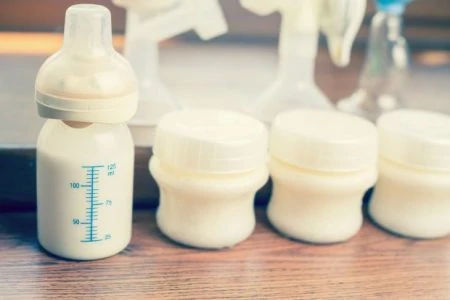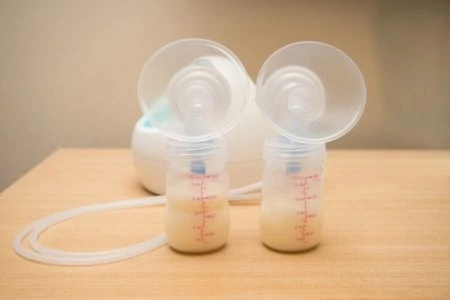You don’t have to carry a pregnancy to breastfeed. Whether you are adopting, using a surrogate, or are the non-gestational partner in a relationship, you can still share that nursing bond with your little one.
Induced lactation allows your body to produce milk without pregnancy. It requires dedication, time, and the right tools, but it is entirely possible for many parents.
Here is the straightforward guide on how to induce lactation, the protocols involved, and what you need to know to succeed.
Key Takeaways
- Induced lactation mimics pregnancy hormones and physical stimulation to trick the body into making milk.
- The most critical factor is frequent, hospital-grade breast pumping to establish a supply.
- Protocols like Newman-Goldfarb use birth control pills and medication to prepare the body months in advance.
- Many parents use a Supplemental Nursing System (SNS) to breastfeed while ensuring the baby gets enough nutrition.
What Is Induced Lactation?
Induced lactation is the process of making breast milk without currently being pregnant or having given birth. It is often referred to as adoptive breastfeeding.
This method allows a non-gestational parent to nurse a baby. This is common for:
- Adoptive parents.
- Intended parents via surrogacy.
- The non-carrying partner in a lesbian or queer relationship (sometimes called co-nursing).
- Transgender women or non-binary parents.
Can You Induce Lactation Without Being Pregnant?
Yes, absolutely. The biology behind it is fascinating but simple.
While pregnancy kickstarts the process, the hormone responsible for making milk (prolactin) comes from the pituitary gland in your brain, not the uterus. If you have a functioning pituitary gland, your body can learn to lactate.
However, success varies. Some parents produce a full milk supply, while others produce a partial supply and supplement with formula or donor milk. Both outcomes offer the same bonding benefits.
How Lactation Works (The Science)
To understand induction, you have to look at how the body normally prepares for milk.
During pregnancy, the placenta releases high levels of progesterone and estrogen. This preps the breast tissue. When the baby is born and the placenta is delivered, those hormone levels crash. This drop signals the pituitary gland to release prolactin, which starts milk production.
When a baby nurses (or you pump), it triggers two things:
- Prolactin: Tells the body to make more milk.
- Oxytocin: Triggers the “let-down” reflex, allowing the milk to flow.
Induced lactation hacks this system. You mimic the pregnancy hormone levels first, then simulate the “birth” by stopping the hormones and starting intensive stimulation.
How to Induce Lactation: The 3 Methods
There are a few ways to approach this. The most successful methods, like the Newman-Goldfarb protocols, combine medication with physical stimulation.
Generally, the process involves three pillars:
- Hormone Preparation: Taking estrogen and progesterone (often via birth control pills) to mimic pregnancy.
- Physical Stimulation: Intense pumping or hand expression to empty the breasts.
- Galactagogues: Herbs or medications that boost milk supply.
1. Hormone Therapy (The Preparation Phase)
If you have months before the baby arrives, doctors often recommend a “standard protocol.”
You take an oral contraceptive (birth control pill) containing estrogen and progesterone. This tricks your body into thinking it is pregnant. You typically stay on this for several months.
About six weeks before you plan to start nursing, you stop the pills. This drop mimics the birth of the baby and the delivery of the placenta, signaling your body to start making milk (1).
2. Breast Stimulation (The Pumping Phase)
This is the non-negotiable part. You cannot induce lactation without removing milk frequently.
When you stop the hormones, you must start pumping. To make an informed buying decision, you need a hospital-grade double electric breast pump. Do not rely on a manual pump or a standard wearable pump for induction; they rarely have the motor strength needed to establish a supply from scratch.
The Standard Pumping Schedule:
- Pump every 3 hours around the clock, including at least once between 1 AM and 5 AM when prolactin levels are highest.
- Aim for 15 to 20 minutes per session.
- Massage your breasts while pumping (hands-on pumping) to maximize stimulation.
It creates a supply-and-demand loop. The more you pump, the more you tell your brain a baby is hungry.
3. Galactagogues (Supplements & Meds)
A galactagogue is simply anything that increases milk supply. These are helpful boosters, but they won’t work without the pumping.
Do Herbal Supplements Work?
Many parents use herbs to support their supply. The evidence is mixed, but they are generally considered safe in moderation.
- Fenugreek: The most common herb used. The standard dosage is often 3 capsules (approx 1500mg total) three times a day. Note: It can cause stomach upset in you or the baby and isn’t recommended for those with diabetes or thyroid issues.
- Blessed Thistle: Often paired with fenugreek.
- Moringa (Malunggay): A nutrient-dense superfood often used to boost supply.
- Goats Rue: Specifically noted for helping build breast tissue (2).
Prescription Medications
Two prescription drugs are commonly used for induction:
- Domperidone: Widely used in Canada and Europe for lactation induction. It increases prolactin levels significantly. It is not FDA-approved in the US for this purpose due to potential heart risks, so it must be discussed carefully with a doctor.
- Metoclopramide (Reglan): Similar to domperidone but crosses the blood-brain barrier and has a higher risk of side effects like depression or fatigue.
The Supplemental Nursing System (SNS)
This is a vital tool for induced lactation. An SNS allows you to feed your baby formula or donor milk at the breast via a tiny tube.
Why is it important?
- Baby gets fed: It ensures your baby gets full nutrition even if your supply is low.
- Stimulation: The baby suckling at the breast stimulates your body to make more milk better than any pump can.
- Bonding: You get the breastfeeding experience immediately.
If you are preparing to buy gear for induced lactation, an SNS starter set is just as important as your pump.
FAQs About Induced Lactation
Here are the answers to common questions about adoptive breastfeeding and relactation.
Breastfeeding Is About Connection
Biology is amazing, but it isn’t everything. Induced lactation allows you to experience the physical closeness of nursing, regardless of how your baby came to you.
Remember that success isn’t all-or-nothing. Whether you provide 100% of your baby’s milk or breastfeed for comfort while supplementing with a bottle, the bond you build is real. Consult a lactation consultant (IBCLC) who specializes in induction to help you create a plan that fits your life.










